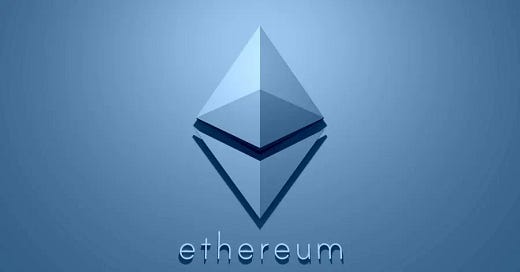Cryptocurrency and Digital Assets, a 50 year old controversial endeavour:
Since the beginning of the internet as we know it, arguably recognized to be born on the 1st of January 1983, the concept of digital money has been in the works. The first theoretical idea is widely attributed to David Chaum in a paper written in 1982, where he introduced Ecash. After several foundational iterations through the 80s, 90s and early 00s, Bitcoin first came online in 2009 where Satoshi Nakamoto created the first widespread and successful cryptocurrency. Satoshi Nakamoto is the pseudonym of the anonymous creator. No-one knows who or what it is. Some speculate about government intelligence agencies, others that it’s a famous academic. It's a really interesting story, but not concerning this article.
Bitcoin & Blockchain:
Bitcoin is widely known as an asset, people say: “i own 2 Bitcoins”. But, speaking more in depth, Bitcoin is both an asset and a very sophisticated type of database. For simplicity let’s say “Bitcoin” when referring to the database and “BTC” when referring to the asset. The database is sophisticated because it uses cryptography in order to be:
1) Decentralized: Because no central agent can unilaterally exert control over its operations or core rules. Therefore, there can be no unilateral censorship, no corruption and no bad practices performed by such an agent when using this database;
2) Permissionless: Anyone can use it, anywhere, anytime under any conditions as long as they have the hardware and an internet connection without having to ask for permission from any authority to do so. This means than no-one can forbid a user of the Blockchain from transacting at their discretion. Unless invasively hacking its computer or physically preventing them from doing it;
3) Transparent & Pseudonymous: All transactions and code are public, but the creators of the transactions are just alphanumeric strings, meaning there is no name, address, etc. attached to any account. So all processes are transparent for everyone to see that they happened and they were done properly;
4) Immutable: Transactions cannot be censored retroactively. Once a transaction or any status change is published in the database it will remain as it is forever.
5) Peer-to-peer: there are no intermediaries gathering data or imposing unreasonable conditions on transactions. The transaction happens between sender and receiver, directly.
6) Trustless: People transacting with each other don’t have to trust on the counterparties good payment, they just have to trust how the network is constructed and everything goes smoothly
In the end, it is just an accounting log where transactions are logged.
So let's keep using the Accounting analogy: Bitcoin = an accounting log, and BTC = the unit of account for the accounting log. A more particular analogy would be Bitcoin = SAP software and BTC = USD. In the Bitcoin Blockchain, people can register transactions sending BTC to other addresses.
In the original Bitcoin Blockchain we can only perform three activities: send BTC, vote on some specific parameter changes (sort of) and mine BTC. [Lately, using some additional technology, the Bitcoin Blockchain (or Bitcoin blockchain, supported by the lightning secondary network) has been able to perform more complex tasks than the aforementioned three capabilities. But Bitcoin is hard to use, slow and very unfriendly to non-programmers.]
Generally speaking, a Blockchain is a type of Distributed Ledger. A Distributed Ledger is a database distributed amongst a network of computers that interact directly between each other. All participants store the same information, consisting of transaction records. This creates a decentralized database with numerous copies, ensuring data preservation and access for all participants. A Blockchain, specifically, uses cryptographic concensus mechanisms as ways to ensure truthful information is published across all copies.
There are currently tens of thousands of computers, also called nodes, all around the world logging Bitcoin transactions. Some of these nodes chose to participate as Miners.
The famous Bitcoin Miners are, essentially, accountants. These miners are responsible for receiving requests for transactions and logging the transactions into the accounting ledger. Users can ask miners (accountants) for their accounting services at any time. They ask for a transaction to be certified as true by them (which makes it true for everyone), the miners accumulate requests and publish an update of new transactions about every 10 minutes. As a reward, they get Bitcoin for their accounting services once they have performed the job.
For reasons not detailed in this article, it should be noted that the Bitcoin blockchain is among the most secure methods of transmitting information between parties who do not trust each other. No one has successfully altered the core data recorded on the Bitcoin blockchain itself. It is virtually impossible to steal BTC directly from the blockchain, maliciously change the network’s core principles, increase the final supply of BTC or validate false transactions due to its cryptographic and consensus-driven nature called Proof of Work.
Store of Value:
There will only ever be 21 Million Bitcoins in the Bitcoin Blockchain, which makes it a scarce asset. And so, now, knowing what we know, we can start to understand where people claim Bitcoin’s value comes from.
Its two fold:
First of all, from its scarcity. In Economics, the Scarcity Principle notes that if a good’s supply is scarce, relative to its demand, the price of that good will increase in order to achieve a market equilibrium. Therefore, if BTC’s demand grows, price could increase because, by design, supply won’t be able to keep up.
The Second reason notes why it is desirable (demanded). And it’s because of the properties we mentioned earlier: decentralization, trustless transacting, etc. that make the handling of a scarce asset easier and gives assurances about the asset itself.
Put this two together and you get: Demand + Limited Supply (Inelastic Supply) = Scarcity. For reference, gold is also a scarce asset, but is really hard to handle, it is heavy and has legal constraints on its transport.
Gold vs. Bitcoin
Gold is a scarce metal, there are only believed to be about 244k metric tonnes of it in Earth. Historically, gold was a great pragmatic solution in order to simplify the exchange of goods. Gold also has great practical applications, besides being a financial commodity. Applications like Aerospace Engineering, Bioresearch, Infrared Reflectivity, etc. where gold is a great performing alternative. Gold is also a cost effective (good enough) alternative to things like Platinum (much scarcer at 10k metric tonnes). Finally, Gold is considered a key element in jewelry and luxury goods as it is aesthetically pleasing to people and, historically, conveys status and has been used as a means of storing value.
Due to all this, Gold has been progressively abstracted as an exchange traded commodity through products that convey a virtual representation of it. In general, people and institutions buy gold-backed financial products under the presupposition that gold is valuable to other people. Although they do not have the capacity or right to store or make any practical use of this gold by purchasing most of these products (delivery settled futures excluded), they purchase with the intent of selling later at a stable price.
Gold itself has an intrinsic value (it is valuable by itself) as companies will want to buy it to be used in solutions for things like Aerospace electronics because it has great properties to perform within those contexts. But Gold as a store of value (ex. i buy a gold watch because someone will want a gold watch and will buy it from me if I want to) is a much more speculative way to assign value to it.
So lets define, for the purposes of this article: Intrinsic Value = Something that is desired or demanded because it can provide value for something/someone even if it is not possible to sell it or exchange it.
Gold has Intrinsic Value under this definition. It can be used for practical purposes to create goods that can be useful. SpaceX will demand Gold because it’s useful to its purpose of aerospace electronics, if SpaceX finds gold they don’t have to sell it or exchange it for it to provide value. But an important part of gold’s value comes from the perception that it’s easy to sell at a relatively stable price. So part of gold’s value is speculative. Because of this, in my opinion, gold of course has value, but given the speculative nature of the store of value part of gold’s demand, it is likely to be overvalued from an intrinsic perspective.
Bitcoin, under its initial concept, has no intrinsic value using this definition. If I had 100 Bitcoins but could not go to the market to sell them, then they would not be helpful to me at all. I could just send them to other people for the fun of it, but who would even want them if they couldn’t be sold?
So, for Bitcoin, demand comes mostly from the expectation that the asset can be later sold at a higher price. [There are some exceptions where some people still believe it can be integrated into something more useful through the lightning chain, but, as we will see in the next chapter, i do not believe this, and also i’m pretty sure that most demand for Bitcoin does not come from this assumption.]
The Ethereum Foundation and ETH Demand
On July 30th 2015 a very important character named Vitalik Buterin lead the Ethereum Foundation on the launch of the Ethereum Blockchain.
Again, Ether (ETH) is not the same as Ethereum. Ether is an asset, which is the unit of account and Ethereum is a Blockchain (a database). ETH (Ether) = Unit of account, Ethereum = Accounting Log. The Blockchain’s unit of account can also be referred to as its Native Token. Ethereum has its accountants, just as Bitcoin but for Ethereum they are called Validators and not Miners.
Ethereum’s users have two ways of compensating accountants for helping Ethereum users do the accounting:
A reward that comes directly from printing new Ethereum
An incentive fee, or we could call them TIPS (To insure prompt service), from people making the transactions.
If I want a transaction done really quickly I can give extra incentives (TIPS) to the accountant for him to prioritize my transaction over others. I do this by paying him an extra if he puts me first in line. As a result, we always have to pay what is called a “gas fee” to make transactions on the Ethereum Blockchain.
This payment to the accountants for the Gas Fee can only be made in ETH. Even if I wanted to, I could not pay Validators in USD, JPY, Gold or any other currency or asset to make transactions. They just accept ETH. So now we have a basic framework for understanding Ether’s demand: people who want to make transactions in the Ethereum Blockchain must necessarily acquire ETH to pay for them.
- Gas fees consists of a Base fee and an Incentive fee, the ETH paid for base fees is taken out of circulation as a way to make the token more scarce.
Now we have a model under which we get that, in the case people wanted to use the Ethereum chain, they would have to purchase or otherwise get ETH to do so. Now let’s move on to the second part: why would people would want to use the Ethereum Blockchain?
Smart Contracts on Ethereum:
A huge amount of the modern world’s daily activities are based on updating databases. Banking transactions, social media posting, central bank money supply, etc. It is all changes to a digital database. For example, the bank determines your balance by updating its transaction database. The big revolution of Ethereum is on track to solve the problems that have historically plagued most private databases, like: transparency, inter-database integration, issues of physically up-keeping servers to store information, etc.
The Ethereum Blockchain, as opposed to the Bitcoin Blockchain, was created with multipurpose DNA from the foundation. The original idea stated that: only being able to send, receive and mine ETH was not enough. Blockchain technology was meant for so much more. But always maintaining the core concepts of decentralization, trustless, permissionless, etc. intact.
So Ethereum pioneered the idea of Smart Contracts (computer programs / algorithms), and ERC Tokens (fungible and non fungible contract-enabled tokens).
This Smart Contracts would allow anyone to code automated computer program on top of the Ethereum Blockchain and the Ethereum accountants would document all the activities of these computer programs into the immutable, decentralized, permissionless, etc. Blockchain. Essentially allowing the program or application to have the same aforementioned benefits as the Blockchain itself. These programs are called dApps (Decentralized Applications). These dApps do not need to be run by people they have initial rules on what to do and they follow these rules, people can alter some parts of the rules, but they are services that run automatically.
Adding on to that, different than the Bitcoin Blockchain (Where BTC is the only thing that can be sent and received), ETH is not the only asset that would be able to exist and be transacted on the Blockchain. Anyone can create what is called an ERC20 (Fungible Tokens) or ERC721 (Non- Fungible Tokens - NFT) token. These tokens can have unlimited applications like simulating stocks, currencies, populations, property titles, etc. ERC tokens are very similar to ETH in practice, but accountants do not receive them as payment for Blockchain accounting and they have to be transacted through the “supervision” of an application (contract).
The combination of having applications that can transact ETH and other tokens resulted in a brilliant invention, a revolution for one of the most fundamental activities today, database management.
So lets give a concrete example about this multipurpose applications using USDT:
Tether, a pioneer crypto company, launched USDT a few years back. It's an ERC-20 token with the aim of providing a stable digital currency equivalent to the US dollar, especially useful for users on platforms like Ethereum. USDT, a stablecoin, seeks to maintain a 1:1 relationship with the USD. Tether backs USDT with real USD and created a Smart Contract program that helps it achieve the 1:1 relationship
So let’s do a comparative case study with three potential scenarios to understand the value:
SCENARIO 1:
Let’s pretend we live in 1985. It’s friday afternoon in New York and I have an import/export business. Im importing in something from Nigeria. The seller contacts me by phone and tells me that I owe him 20,000USD for the goods and if I don’t pay him this same day he is going to hold the merchandize until it’s paid for and penalize me for the delay. In 85 Nigeria was not part of the SWIFT payment system. So, unless I had some affiliated party in the ground in Nigeria with enough money, it would be impossible for me to pay him 20,000 that same day. My transaction would have been delayed for several days or weeks. I would have been penalized and my clients would have been upset
.
SCENARIO 2:
Imagine the same scenario in 2010. Nigeria is, at this point, part of the SWIFT system. I could wire 20,000 USD to a Nigerian account, but It would be subject to:
1) FedWire operating hours and days, so no luck if its a Holiday or its past the effective hours.
2) Expensive fees. SWIFT international transactions on US banks come with a bank fee, 25 USD on average per transaction and a Forex fee for exchanging USD for NGN (Nigerian Naira) on the international markets.
3) Bank scrutiny and censure. Given that i’m transferring >10,000 USD into a high risk jurisdiction, banks will want a lot of information about the transaction. This could take several hours. If things don’t go right, the transaction will be cancelled and all account movements could be halted for some cooldown time or until further notice. This can trigger audits, investigations and all kinds of problems.
4) Long processing times. Even if all things go well regarding the bureaucratic process, the processing time for these types of transactions are still in the hours or days.
So, most likely, the merch will be delayed for a couple of days and the bank transaction will be expensive. Clients will still be upset and I will be penalized.
SCENARIO 3:
Same scenario, but its 2020 and I adopt the use of USDT as payment and my contact in Nigeria does too. I just open my wallet or exchange and send 20,000 USDT to his wallet. The transaction happens at an average cost of 0.00015ETH (0.5USD) - 0.0015ETH (5 USD) and it gets to him in under 30 seconds. Moreover, the service is available 24/7/365 with no intermediaries. The transaction will always go through at the right price, which is usually cheap. I get the merch on time and clients are now happy. My provider in Nigeria goes to a crypto exchange, swaps USDT for his local currency and withdraws the money instantly.
Why would someone want to use the Ethereum Blockchain? Exactly because of companies like Tether creating USDT and improving 10X the international money transmission infrastructure along with countless other applications that are possible thanks to smart contracts.
Important Ethereum based service “companies” include:
AAVE: Loans and automated money markets
Uniswap: Decentralized exchanging of digital assets
Yearn Finance: Automated Blockchain based hedge funds
Opensea: NFT marketplace
These “companies” currently generate millions of dollars from processing billions of dollars worth of transactions. They have governance tokens, that are somewhat similar to owning company stock, and are open source.
Applications:
Ethereum is not the only Smart Contract Blockchain, but it is the most established. Competitors like Solana, Tron, Avalanche, Canto etc. have been trying to take market share away from Ethereum for some time. But, developers keep building an bettering Ethereum through updates to the Blockchain itself as well as third party applications that help with cheaper transaction prices, optimizing the network for specific purposes and many other improvements.
Broadly speaking, these are some of the thousands of possible things that could be massively improved by adapting them into the Ethereum Blockchain
Decentralized social media: Stops unilateral censorship, content creators will be able to directly and fully monetize their content and own the platform they create for.
Stock and Commodity Brokerage: tokenized stocks and ETFs would be able to trade 24/7/365 in the Blockchain and they would cut in half the amount of transactions needed to rebalance portfolios
Voting: NFTs could work as unique identifiers through which people could vote in elections with more transparency.
Invoices and Ownership Titles: NFTs are not falsifiable, so creating the title for a house through an NFT would really improve the home ownership procedures.
Gaming: rerouting the already enormous market and traffic of gaming through the Blockchain for improved leaderboards, monetization of in-game purchases and more.
Financial Administration, Asset Custody and Investing: more transparent but anonymous, with self-custody. Owners of assets would be able to eliminate counterparty risk (eg. bank going bankrupt). Public investment vehicles would ensure investors that their money is safe, automated money markets could improve access to credit and decrease default rates.
Endless possibilities…
Conclusion:
Smart contract Blockchains have thousands of applications that could improve existing services in a huge range of sectors. In order to have access to those improved services the native asset, like Ether in Ethereum, must be purchased and held to pay the accountants for transactions.
Let’s go back to our useful definition of intrinsic value. If I purchased some ETH I could use the ETH for valuable purposes without needing to sell it or exchange it for anything else. Therefore, Smart Contract Blockchain native tokens have indisputable intrinsic value and organic demand which will grow over time. Additionally, Ethereum has many other mechanisms like Staking or Burning that potentiate the potential market value of an already valuable asset.
ETH is nowhere near to a scam, it's a key component to a revolutionary infrastructure technology that can absorb and improve many of the key activities in today’s world.












